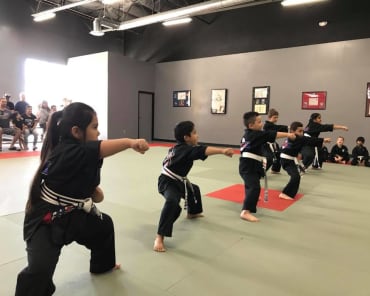
The idea might sound insane to some people: You’re going to pay money so you can go to a class every few days and get beat up. But that’s just what it looks like to outsiders. There are many types of martial arts, and training in one is about much more than dealing out (and receiving) punishment. It can be highly rewarding, both for your fitness and your overall well-being.
For beginners, the hardest part of martial arts might be choosing one to start with. Picking the right one for your goals is crucial if you’re going to enjoy yourself and stick with it. To help with that decision, we’ve put together this guide to some of the main types of martial arts out there (classes for the seven disciplines below are generally easy to find). Choose one that matches your preferences, and get ready to experience a whole new way to stay fit, build mental toughness, and more.
Muay Thai/Kickboxing
What is it? The term kickboxing has become a blanket term to cover anything that involves punching and kicking, but Muay Thai has a few distinct features. It’s a centuries-old practice that comes from Thailand. In addition to fists and feet, it also involves knee and elbow strikes as well as a form of stand-up grappling called the clinch.
Where you’ve seen it: One of the most famous big-screen representations of Muay Thai comes from none other than Jean Claude Van Damme in Kickboxer. But if you want something more recent—and with less awkward dancing—you can check out the Ong Bak movies starring Tony Jaa. The techniques are also commonly used in the UFC.
What to expect: Techniques are learned through drilling combos on pads called Thai pads. Once you’ve learned to properly throw the strikes, you’ll move into real sparring. The sparring is mean to your shoulders and hips, but the clinch is a particularly brutal test of your core endurance.
Is it for you? If you have dreams of competing in a martial art, this is a good way to go. Many MMA fighters use Muay Thai as the basis for their striking game, and amateur kickboxing matches aren’t hard to come by. If you’re already flexible, you’ll probably have an easier time at the start, especially with the kicks. But don’t worry if not, you’ll get there. From a self-defense standpoint, Muay Thai is one of the best in terms of practicality.
Brazilian Jiu-Jitsu
What is it? This ground-based grappling technique broke off from judo in the early 1900s. It rose to mainstream prominence more recently: Royce Gracie used it to dominate the early UFC tournaments. In BJJ, the object is to put your opponent in a submission hold that either knocks them out or inflicts so much pain that they have to submit.
Where you’ve seen it: If you’ve ever watched a UFC event, you’ve definitely seen BJJ in action.
What to expect: At the core of most jiu-jitsu training is what’s called “rolling,” which is basically wrestling. You’ll either be rolling gi—in which you wear a traditional uniform—or no gi, which usually just involves a pair of shorts and a T-shirt. To the untrained eye, students who are rolling might sometimes look like they’re just laying there, but it’s a very intense full-body workout. (Think Pilates in attack mode.) It’ll also give you an iron grip.
Is it for you? If your primary goal is self-defense, this is a good choice, since taking a guy to the ground can be a good strategy eapecially if the attacker is bigger. If you have personal space issues, BJJ will Definitely help cure that. But if you’re in it for sport, this might be the best martial art. BJJ tournaments are becoming more common, and you (usually) won’t end up injured if you lose.
Taekwondo
What is it? Hailing from Korea, taekwondo is one of the broadest types of martial arts. Statistically speaking, it has more followers than any other martial art, and it’s even an Olympic sport. Attacks include punches, kicks, and throws.
Where you’ve seen it: It’s one of the most entertaining events at each summer Olympics. The discipline’s flying kicks have made their way into popular video games like Street Fighter and Mortal Kombat.
What to expect: Most taekwondo programs include a wide variety of activities. You’ll do a lot of drills and a fair bit of sparring, but training also involves learning relaxation techniques, standard cardiovascular exercises, and breaking objects like boards and bricks with your hands and feet.
Is it right for you? Because the programs can vary so much, it’s important to really check out classes in your area and observe a bit before committing. Since much of the sparring is done in full gear, there’s often more eqipment. (That means more protection for you, though.) Because of taekwondo’s Olympic status, finding opportunities for competition should be easy.
Mixed Martial Arts (MMA)
What is it? Mixed martial arts hasn’t been in the U.S. for long, but it sure has changed a lot since the early days of the UFC. What started as a collection of fighters facing off Bloodsport-style has evolved into a mature sport with a large following and lots of nuance.
Where you’ve seen it: Aside from the UFC, MMA was also given the big-screen treatment in the movie Warrior starring Tom Hardy.
What to expect: Most MMA programs consist of several parts, including a standup element and a grappling element. They usually draws on Muay Thai techniques for striking and wrestling and Brazilian jiu-jitsu for building up the ground game. Contact will be very common, and you can expect to leave class exhausted. Is it for you? Because there are so many aspects to MMA, it usually requires a bigger time and money commitment than some other martial arts. But because you’re doing so much work, it usually offers a superior workout. As for self-defense, MMA is a good discipline for protection—it teaches fighters to handle a wide range of situations. It’ll also make watching the UFC a lot more exciting.





